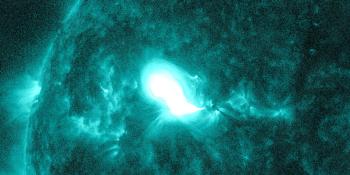Viewing archive of Wednesday, 11 May 2011
Solar activity report
Any mentioned solar flare in this report has a scaling factor applied by the Space Weather Prediction Center (SWPC). Because of the SWPC scaling factor, solar flares are reported as 42% smaller than for the science quality data. The scaling factor has been removed from our archived solar flare data to reflect the true physical units.
Report of Solar-Geophysical Activity 2011 May 11 2200 UTCPrepared by the NOAA © SWPC and processed by SpaceWeatherLive.com
Joint USAF/NOAA Report of Solar and Geophysical Activity
SDF Number 131 Issued at 2200Z on 11 May 2011IA. Analysis of Solar Active Regions and Activity from 10-2100Z to 11-2100Z Solar activity was very low. A B8 x-ray flare occurred
at 11/0243Z, likely associated with a filament eruption between
Regions 1205 (N14W75) and 1207 (N21W51). The flare was associated
with a Type II radio sweep and a partial-halo coronal mass ejection
(CME). The CME had an estimated plane-of-sky speed of 420 km/s,
based on SOHO/LASCO images. No significant changes occurred in any
of the spotted regions. New Region 1212 (S13E46) was numbered and
was classified as a single-spot Axx region.
IB. Solar Activity Forecast
Solar activity is expected to be very
low during the period (12 - 14 May) with a chance for isolated
C-class flares.
IIA. Geophysical Activity Summary 10-2100Z to 11-2100Z
Geomagnetic activity was at quiet to unsettled levels. ACE solar wind
data indicated Earth remained under the influence of a recurrent
coronal hole high-speed stream (CH HSS). Solar wind speeds ranged
from 352 to 414 km/sec with no discernible trend. A slight increase
in the greater than 10 MeV proton flux occurred in the wake of the
B8 flare mentioned above.
IIB. Geophysical Activity Forecast
Geomagnetic activity is
expected to be at unsettled to active levels on day 1 (12 May) with
a chance for minor storm levels as the CH HSS persists. The CME
observed late on 09 May may also disturb the field on May 12.
Activity is expected to decrease to quiet to unsettled levels on day
2 (13 May) as the CH HSS begins to subside. Activity is expected to
decrease to quiet levels on day 3 (14 May). The CME observed today
is not expected to affect the field during the forecast period.
III. Event Probabilities 12 May to 14 May
| Class M | 10% | 10% | 10% |
| Class X | 01% | 01% | 01% |
| Proton | 01% | 01% | 01% |
| PCAF | green | ||
IV. Penticton 10.7 cm Flux
Observed 11 May 094 Predicted 12 May-14 May 095/095/095 90 Day Mean 11 May 110
V. Geomagnetic A Indices
Observed Afr/Ap 10 May 005/008 Estimated Afr/Ap 11 May 005/005 Predicted Afr/Ap 12 May-14 May 015/015-008/010-005/005
VI. Geomagnetic Activity Probabilities 12 May to 14 May
| A. Middle Latitudes | |||
|---|---|---|---|
| Active | 35% | 10% | 05% |
| Minor storm | 15% | 05% | 01% |
| Major-severe storm | 05% | 01% | 01% |
| B. High Latitudes | |||
|---|---|---|---|
| Active | 40% | 15% | 10% |
| Minor storm | 20% | 10% | 01% |
| Major-severe storm | 10% | 01% | 01% |
All times in UTC
Latest news
Latest forum messages
More topicsSupport SpaceWeatherLive.com!
A lot of people come to SpaceWeatherLive to follow the Sun's activity or if there is aurora to be seen, but with more traffic comes higher server costs. Consider a donation if you enjoy SpaceWeatherLive so we can keep the website online!

Space weather facts
| Last X-flare | 2024/11/06 | X2.39 |
| Last M-flare | 2024/11/25 | M9.3 |
| Last geomagnetic storm | 2024/11/10 | Kp5+ (G1) |
| Spotless days | |
|---|---|
| Last spotless day | 2022/06/08 |
| Monthly mean Sunspot Number | |
|---|---|
| October 2024 | 166.4 +25 |
| November 2024 | 145.5 -20.9 |
| Last 30 days | 158.8 +11.1 |


